There’s an effective response to the savage treatment of roadside verges by local authorities: say it with flowers.

Revenge, the saying goes, is a dish best served cold. I’m not the only gardener to have looked on aghast at the treatment that’s been meted out to the wild flowers (not to mention the wildlife) along our roadside verges, embankments and other strips and scraps of ‘public’ land over the summer months. Yes, there are signs that those responsible for the ‘safety’ of our highways are finally ‘getting’ that our roadsides (however litter-strewn they may be) are one of the last refuges for wild plants which have been purged from intensively-farmed monocultures across our landscape. But in many areas wild flowers – and all of the life that goes with them – exist precariously in narrow strips, just beyond the reach of the weedkillers that rain down on the fields from which we extract much of our food.
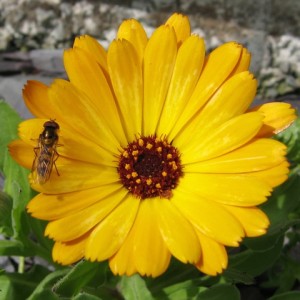
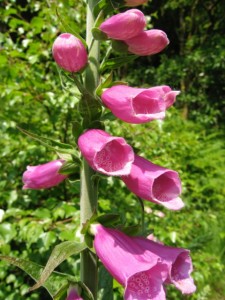
My bombing campaign will bring new life to dull, strimmed and sprayed-to-death strips of earth, barren car parks, footpaths, overlooked building plots, the weedkiller-poisoned edges of school playing fields, boring traffic roundabouts, abandoned gardens… choose your targets and start planning your own. You don’t need anyone’s permission, and it’s dead easy. What you will need is some wild/garden flower seeds, some mature, crumbly leaf mould, fungicide-free wallpaper paste (or the preservative-free cellulose adhesive used in making papier mache) and a bucket.
How to make bombs that bloom
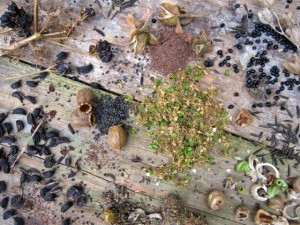
1. Gather a variety of flower seeds. The lane gave me cow parsley (Anthriscus sylvestris), red campion (Silene dioica), primrose (Primula vulgaris), foxglove (Digitalis purpurea), sheep’s-bit scabious (Jasione montana), hedge garlic (Alliaria petiolata) and meadowsweet (Filipendula ulmaria). The garden yielded pot marigold (Calendula vulgaris), Welsh poppy (Meconopsis cambrica), ox-eye daisy (Leucanthemum vulgare) and bluebell (Hyacinthoides non-scripta). I gathered alexanders (Smyrnium olustratrum) from the roadside a few miles away.
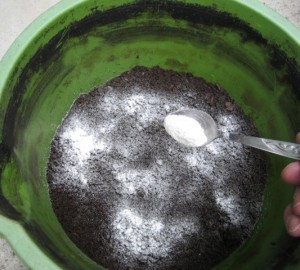 2. Compost and soil are too precious to use for flower bombs, so I use well-rotted leaf mould, which I have oodles of. After passing it through a 6mm (1/4in) sieve, I add a teaspoonful of wallpaper paste to roughly half a bucket of leaf mould, and mix thoroughly. The leaf mould should be moist enough so it just exudes water when squeezed. If it’s dry, moisten it first. The paste helps stick the bombs together.
2. Compost and soil are too precious to use for flower bombs, so I use well-rotted leaf mould, which I have oodles of. After passing it through a 6mm (1/4in) sieve, I add a teaspoonful of wallpaper paste to roughly half a bucket of leaf mould, and mix thoroughly. The leaf mould should be moist enough so it just exudes water when squeezed. If it’s dry, moisten it first. The paste helps stick the bombs together.
 3. Mix your gathered seeds together and scatter them over the leaf mould, then work them in well so they’ll be distributed throughout each bomb. For a belt and braces mixing, tip the ingredients into an empty compost bag and turn it upside down half a dozen times. Smaller seeds, such as those of Welsh poppy, will disappear into the mix, but you’ll still see larger ones, like smooth and shiny bluebell seeds, when you form your bombs.
3. Mix your gathered seeds together and scatter them over the leaf mould, then work them in well so they’ll be distributed throughout each bomb. For a belt and braces mixing, tip the ingredients into an empty compost bag and turn it upside down half a dozen times. Smaller seeds, such as those of Welsh poppy, will disappear into the mix, but you’ll still see larger ones, like smooth and shiny bluebell seeds, when you form your bombs.
 4. Now comes the therapeutic part of bomb-making: take a fistful of the mix, squeeze it together (this is where the cellulose paste does its stuff) and mould it into a ball. Use both hands to knead the mix, then roll it between them for the final finish. Aim for somewhere between golf- and tennis-ball size; bigger bombs will travel further. Some seeds will be embedded in the bomb’s outer casing.
4. Now comes the therapeutic part of bomb-making: take a fistful of the mix, squeeze it together (this is where the cellulose paste does its stuff) and mould it into a ball. Use both hands to knead the mix, then roll it between them for the final finish. Aim for somewhere between golf- and tennis-ball size; bigger bombs will travel further. Some seeds will be embedded in the bomb’s outer casing.
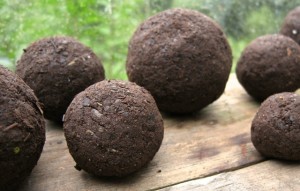 5. Freshly made bombs are good to drop straight away. Or, while you plan your campaign, you can stand them in the greenhouse to dry out; once they’re dry the seeds won’t start to grow until the bombs have been deployed and become moist again. Dry bombs are also lighter in weight, should you want to take a pocketful on your next walk, or have them ready to drop in the next lifeless car park.
5. Freshly made bombs are good to drop straight away. Or, while you plan your campaign, you can stand them in the greenhouse to dry out; once they’re dry the seeds won’t start to grow until the bombs have been deployed and become moist again. Dry bombs are also lighter in weight, should you want to take a pocketful on your next walk, or have them ready to drop in the next lifeless car park.
 6. Now it’s time to go flower-bombing. How you do it is up to you: drop them along roadsides and footpaths, or in bare corners of car parks, or fling them onto derelict bits of land to send seeds where they might never otherwise reach. You could even flip the odd one out of the car window (verge-side only, and with care). If the bombs ‘explode’ on impact, their contents are spread wider.
6. Now it’s time to go flower-bombing. How you do it is up to you: drop them along roadsides and footpaths, or in bare corners of car parks, or fling them onto derelict bits of land to send seeds where they might never otherwise reach. You could even flip the odd one out of the car window (verge-side only, and with care). If the bombs ‘explode’ on impact, their contents are spread wider.
You won’t get an instant uprising of blooms with an autumn bombing blitz. Some seeds, such as calendula, foxglove and red campion, will germinate and produce young seedlings straight away. These will then grow slowly and produce flowers next spring and summer. Others, such as cow parsley, won’t come up until next spring. Some might not thrive at all, depending on where the bomb lands, but getting a wide variety of flowers into your mix will ensure that at least some will succeed. I chose my mix because I know that they all provide valuable sources of pollen and nectar for insects over many months, beginning in spring.
Doesn’t this sound like the sweetest, most gentle revenge? Better still, it’s something we can all have a go at. It’s time not to get mad, but to get even – with flowers.
Text and images © John Walker
Find John on Twitter @earthFgardener


